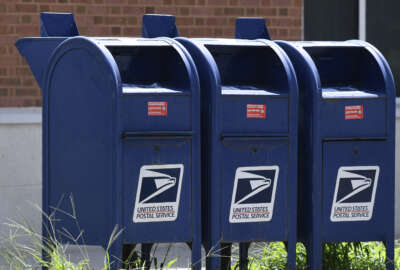USPS brings back holiday surcharge in bid to boost package revenue
USPS expects these temporary price increases will help it bring in $77 million in additional package revenue in FY 2025.
The Postal Service is bringing back a holiday surcharge for some of its package services, as the agency prepares for its busy year-end peak season.
The new prices will take effect on Oct. 6, 2024, and will last through Jan. 19, 2025. USPS announced the return of the holiday surcharge in a press release Thursday.
USPS waived the surcharge last year, in the hopes that that lower prices would help the agency capture a bigger share of the lucrative holiday package business from private-sector competitors like UPS, FedEx and Amazon.
USPS said in a press release Thursday that the temporary price adjustment will “help cover extra handling costs to ensure a successful peak season.”
USPS, according to a filing submitted to the Postal Regulatory Commission, expects these temporary price increases will help it bring in $77 million in additional package revenue in fiscal 2025, but result in the agency delivering 38 million fewer packages.
USPS expects all its competitive products will bring in $34 billion in revenue next year.
The agency delivered more than 7 billion packages in FY 2023, bringing in more than $31.6 billion in revenue. That compared to 7.23 billion packages delivered in FY 2022 bringing in $31.31 billion in total revenue.
The holiday surcharge will amount to a 4.9% average price increase for Priority Mail Express, a 5.5% average increase for Priority Mail and a 6.4% average increase for USPS Ground Advantage. Prices will remain unchanged for Parcel Select, Special Services, or International Competitive products.
The Postal Regulatory Commission will review the proposed price hikes before they go into effect on Oct. 6.
Postmaster General Louis DeJoy told reporters last year that USPS declined to add the surcharge in 2023, because “we’ve made a lot of operational improvements that eliminated some of the extra activities that we had when I first got here.”
Those operational improvements include growth in its career workforce — with better pay and benefits than its pre-career workforce — and the addition of new sorting machines that more than doubled the volume of packages USPS can deliver during the holidays.
Since January 2021, USPS converted 150,000 of its pre-career employees to career positions, “bringing both stability and energy from our workforce to succeed in our mission,” DeJoy said.
DeJoy said USPS added a surcharge in recent years to reflect higher year-end workforce costs, particularly when the agency faced significant staffing shortages at the height of the COVID-19 pandemic.
“Prior to me being here, we never had an incremental charge,” DeJoy said. “We put it in, because in my experience in the commercial business, when you have to do such exponential, extra work, you should, in fact, charge for it — and we did.”
USPS is relying less on seasonal hiring, after building up its career workforce over the past few years. The agency planned to hire only 10,000 temporary, seasonal employees nationwide last year. USPS started to significantly taper its seasonal hiring in 2022 when it brought 20,000 temporary hires on board.
Prior to this new seasonal workforce strategy, USPS would hire tens of thousands of temporary employees each year to meet its holiday season demand.
A recent inspector general report, however, found USPS actually hired more than 15,000 temporary employees for last year’s peak holiday season but still didn’t meet its hiring goals for the season.
The report found USPS hired 12,310 temporary mail processing and distribution employees during last year’s holiday season — about 80% more than planned. However, USPS only hired about half of the 214 holiday city carrier assistants it planned on, and about 65% of its goal was to hire 4,172 holiday clerk assistants.
USPS is legally required to set package prices that cover the cost of delivering them. The agency, however, keeps a close hold on other details, such as the cost to deliver all those packages, and how much of USPS package revenue goes toward their delivery.
The agency told its regulator in a notice that “it is highly likely that if this information were made public, the Postal Service’s competitors and suppliers would take advantage of it almost immediately.”
“If competitors of the Postal Service were to have access to this information, they would likely focus their marketing and price-cutting efforts on the Postal Service’s most profitable products. This will lead to erosion of contribution of these products through lost sales and/or the need to lower prices to compete,” the agency added.
Copyright © 2024 Federal News Network. All rights reserved. This website is not intended for users located within the European Economic Area.
Jory Heckman is a reporter at Federal News Network covering U.S. Postal Service, IRS, big data and technology issues.
Follow @jheckmanWFED






